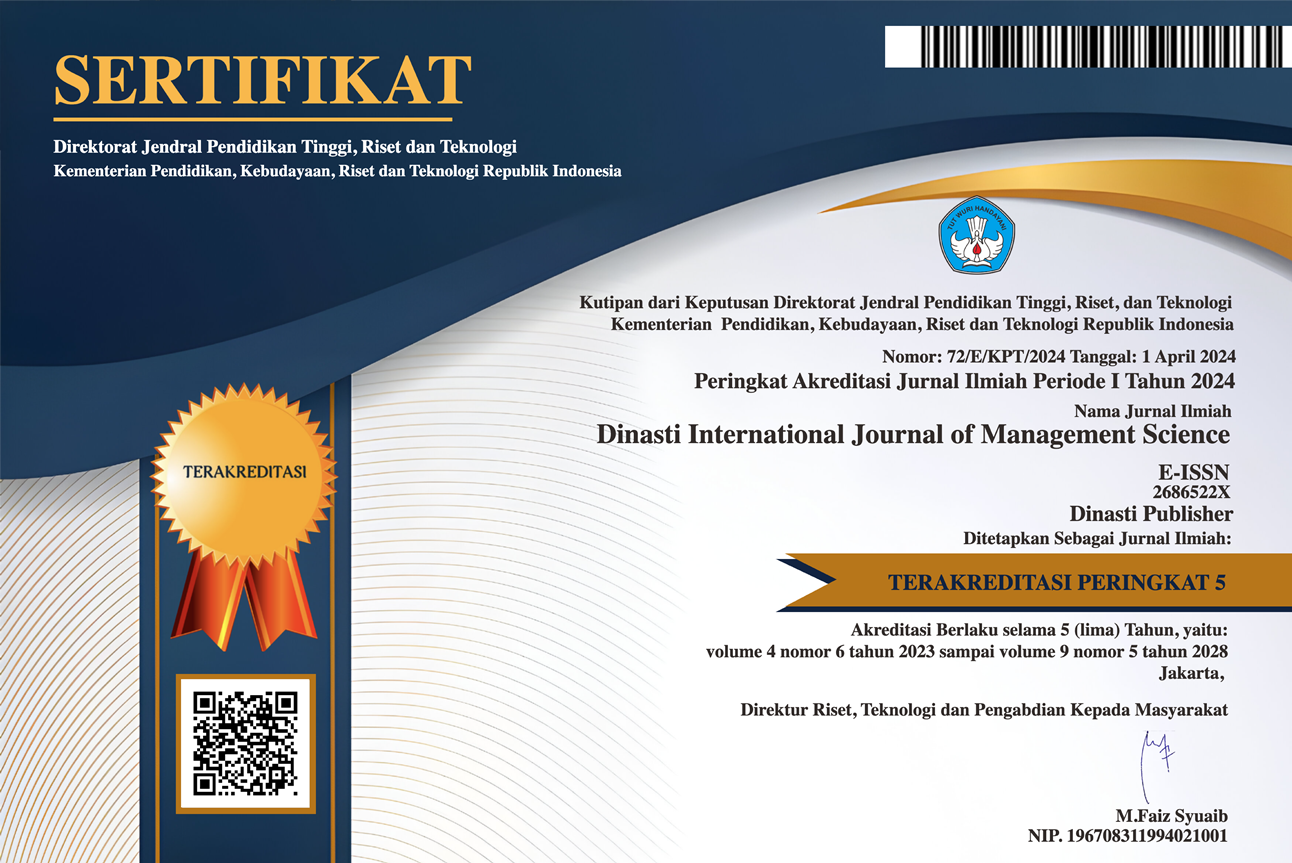Digital Leadership: Accelerating the Process of Talent Mobility and Job Rotation Efficiency in the Government Sector
Keywords:
Digital Leadership, Talent Mobility, Job Rotation, Government SectorAbstract
This study explores the influence of digital leadership on job rotation and talent mobility within the public sector, addressing challenges posed by hierarchical structures and bureaucratic inertia. The research aims to determine whether digital leadership enhances these processes and fosters workforce adaptability. A quantitative approach utilizing Partial Least Squares Structural Equation Modeling (PLS-SEM) was applied to analyze data from 32 Ministry of Communication and Digital Affairs respondents. The findings reveal that digital leadership significantly impacts job rotation and talent mobility, with respective T-scores of 3.438 and 9.702 and P-values below the 0.05 threshold. Digital leadership explains 27.6% of the variance in job rotation and 61.7% in talent mobility, underscoring its role in streamlining career planning and cross-functional development. Tools such as predictive analytics and immersive technologies were identified as pivotal in enhancing talent management practices. This research highlights the transformative potential of digital leadership in overcoming public sector barriers, contributing to more responsive and agile organizational operations. By linking leadership strategies to workforce adaptability, this study provides actionable insights for improving public service efficiency and enriching the theoretical framework of digital leadership. These findings underscore the importance of fostering innovation and continuous learning in addressing contemporary organizational challenges.
References
Abd Rashid, I. M., Zaini, M. R., Roni, M., Adanan, A., Faisal, S. I., & Jamil, M. F. (2022). Job Rotation As A Leadership Development Tool in Malaysia Education Sector. International Journal of Academic Research in Business and Social Sciences, 12(12), 381–388. https://doi.org/10.6007/ijarbss/v12-i12/15344
Acharya, A., Black, R. C., Smithies, A., & Darzi, A. (2022). Evaluating the impact of a digital leadership programme on national digital priorities: A mixed methods study. BMJ Open, 12(4). https://doi.org/10.1136/bmjopen-2021-056369
Ali, M., Ullah, M. S., & Haque, A. (2023). Effect of transactional and transformational leadership on talent engagement: Mediating role of talent development. Global Business and Organizational Excellence, 42(6), 120–137. https://doi.org/10.1002/joe.22214
Baglama, B., Evcimen, E., Altinay, F., Sharma, R. C., Tlili, A., Altinay, Z., Dagli, G., Jemni, M., Shadiev, R., Yucesoy, Y., & Celebi, M. (2022). Analysis of Digital Leadership in School Management and Accessibility of Animation-Designed Game-Based Learning for Sustainability of Education for Children with Special Needs. Sustainability (Switzerland), 14(13). https://doi.org/10.3390/su14137730
Claassen, K., dos Anjos, D. R., Kettschau, J., & Broding, H. C. (2021). How to evaluate digital leadership: a cross-sectional study. Journal of Occupational Medicine and Toxicology, 16(1). https://doi.org/10.1186/s12995-021-00335-x
Espina-Romero, L., Noroño Sánchez, J. G., Rojas-Cangahuala, G., Palacios Garay, J., Parra, D. R., & Rio Corredoira, J. (2023). Digital Leadership in an Ever-Changing World: A Bibliometric Analysis of Trends and Challenges. In Sustainability (Switzerland) (Vol. 15, Issue 17). Multidisciplinary Digital Publishing Institute (MDPI). https://doi.org/10.3390/su151713129
Gadzali, S. S., Gazalin, J., Sutrisno, S., Prasetya, Y. B., & Almaududi Ausat, A. M. (2023). Human Resource Management Strategy in Organisational Digital Transformation. Jurnal Minfo Polgan, 12(1), 760–770. https://doi.org/10.33395/jmp.v12i1.12508
Gierlich-Joas, M., Hess, T., & Neuburger, R. (2020). More self-organization, more control—or even both? Inverse transparency as a digital leadership concept. Business Research, 13(3), 921–947. https://doi.org/10.1007/s40685-020-00130-0
Hair, J. F., Risher, J. J., Sarstedt, M., & Ringle, C. M. (2018). When to use and how to report the results of PLS-SEM. European Business Review, 31(1), 2–24. https://doi.org/10.1108/EBR-11-2018-0203
Hamid, R. S., & Anwar, S. M. (2019). Structural Equation Modeling (SEM) Berbasis Varian: Konsep Dasar dan Aplikasi dengan Program SmartPLS 3.2.8 dalam Riset Bisnis. PT Inkubator Penulis Indonesia, 11(1), 1–5. http://link.springer.com/10.1007/978-3-319-59379-1%0Ahttp://dx.doi.org/10.1016/B978-0-12-420070-8.00002-7%0Ahttp://dx.doi.org/10.1016/j.ab.2015.03.024%0Ahttps://doi.org/10.1080/07352689.2018.1441103%0Ahttp://www.chile.bmw-motorrad.cl/sync/showroom/lam/es/
Hidayat, F., Sumantri, S., Rumengan, A. E., Wibisono, C., & Khaddafi, M. (2023). The Effect of Digital Leadership, Information Technology and Digital Competency on Employee Performance in the Digital Era: Mediating Role of Job Satisfaction. International Journal of Advances in Social Sciences and Humanities, 2(2), 61–68. https://doi.org/10.56225/ijassh.v2i2.204
Jasim, T. A., Khairy, H. A., Fayyad, S., & Al-Romeedy, B. S. (2024). Digital Leadership And Creative Performance In Tourism And Hotel Enterprises: Leveraging Strategic Agility And Organizational Learning Culture. Geojournal of Tourism and Geosites, 54, 872–884. https://doi.org/10.30892/gtg.542spl11-1262
Khaw, T. Y., Teoh, A. P., Abdul Khalid, S. N., & Letchmunan, S. (2022). The impact of digital leadership on sustainable performance: a systematic literature review. Journal of Management Development, 41(9–10), 514–534. https://doi.org/10.1108/JMD-03-2022-0070
Liao, M., Li, S., & Liu, H. (2024). The impact mechanism of telework on job performance: a cross-level moderation model of digital leadership. Scientific Reports, 14(1). https://doi.org/10.1038/s41598-024-63518-6
Loglo, F. S. (2024). Towards Digital Transformation of Selected Ghanaian Public Universities: Leadership Enablers, Challenges, and Opportunities. Open Praxis, 16(3), 374–395. https://doi.org/10.55982/openpraxis.16.3.700
Magambo, J. (2021). Examining the Relationship Amongst Transformational Leadership, Talent Management, and Organizational Effectiveness: A Review of Literature. American Journal of Leadership and Governance, 6(1), 37–66. https://doi.org/10.47672/ajlg.798
Mollah, M. A., Choi, J. H., Hwang, S. J., & Shin, J. K. (2023). Exploring a Pathway to Sustainable Organizational Performance of South Korea in the Digital Age: The Effect of Digital Leadership on IT Capabilities and Organizational Learning. Sustainability (Switzerland), 15(10). https://doi.org/10.3390/su15107875
Müller, S. D., Konzag, H., Nielsen, J. A., & Sandholt, H. B. (2024). Digital transformation leadership competencies: A contingency approach. International Journal of Information Management, 75(December). https://doi.org/10.1016/j.ijinfomgt.2023.102734
Nawaz, N. (2013). Impact of talent mobility on employee performance in software companies, Bangalore. The International Journal of Management, February 2013.
Rakovic, L., Maric, S., Milutinovic, L. D., Vukovic, V., & Bjekic, R. (2024). The role of leadership in managing digital transformation: A systematic literature review. E a M: Ekonomie a Management, 27(2), 87–107. https://doi.org/10.15240/tul/001/2024-2-006
Sagbas, M., Oktaysoy, O., Topcuoglu, E., Kaygin, E., & Erdogan, F. A. (2023). The Mediating Role of Innovative Behavior on the Effect of Digital Leadership on Intrapreneurship Intention and Job Performance. Behavioral Sciences, 13(10). https://doi.org/10.3390/bs13100874
Saraih, E. F., Wong, S. L., Asimiran, S., & Khambari, M. N. M. (2021). Understanding digital public relations practices among exemplar school principals in Malaysian schools. Pertanika Journal of Social Sciences and Humanities, 29(2), 1273–1291. https://doi.org/10.47836/pjssh.29.2.28
Savitri, C., Faddila, S. P., Irmawartini, Iswari, H. R., Anam, C., Syah, S., Mulyani, S. R., Sihombing, P. R., Kismawadi, early R., Pujianto, A., Mulyati, A., Astuti, Y., Adinugroho, W. catur, Imanuddin, R., Kritia, Nuraini, A., & Siregar, M. T. (2021). Statistik Multivariat Dalam Riset. In Widina Bhakti Persada Bandung (Vol. 11, Issue 551). http://webs.ucm.es/info/biomol2/Tema01.pdf%0Ahttp://dx.doi.org/10.1016/j.addr.2009.04.004
Schober, P., Bossers, S. M., & Schwarte, L. A. (2018). Statistical significance versus clinical importance of observed effect sizes: What do p values and confidence intervals really represent? Anesthesia and Analgesia, 126(3), 1068–1072. https://doi.org/10.1213/ANE.0000000000002798
Shin, J., Mollah, M. A., & Choi, J. (2023). Sustainability and Organizational Performance in South Korea: The Effect of Digital Leadership on Digital Culture and Employees’ Digital Capabilities. Sustainability (Switzerland), 15(3). https://doi.org/10.3390/su15032027
Suryadi, Muslim, A. Q., & Praja, B. A. (2023). Analysis Of Digital Leadership In Higher Education In Creating A World-Class University At State Universities. Corporate Governance and Organizational Behavior Review, 7(4), 119–126. https://doi.org/10.22495/cgobrv7i4p10
Susilawati, D. M., Suryanto, & Windijarto. (2021). Transforming the digital leadership to improve public service performance in the COVID-19 outbreak. Economic Annals-XXI, 188(3–4), 31–38. https://doi.org/10.21003/ea.V188-04
Warman, A., Affandi, M. J., Sukmawati, A., Maarif, M. S., Alfiany, H., & Hanifah, R. I. (2022). Digital Leadership: Develop Perceived organizational Support in The Perception of Talent Mobility at Employment Social Security Supervisory Agency. Jurnal Aplikasi Bisnis Dan Manajemen, 8(3), 769–778. https://doi.org/10.17358/jabm.8.3.769
Zulu, S. L., & Khosrowshahi, F. (2021). A taxonomy of digital leadership in the construction industry. Construction Management and Economics, 39(7), 565–578. https://doi.org/10.1080/01446193.2021.1930080
Downloads
Published
How to Cite
Issue
Section
License
Copyright (c) 2024 Afriska Yuni Anggraini, A. Sobandi, Syamsul Hadi Senen, Eeng Ahman, Rofi Rofaida

This work is licensed under a Creative Commons Attribution 4.0 International License.
Authors who publish their manuscripts in this journal agree to the following conditions:
- The copyright on each article belongs to the author(s).
- The author acknowledges that the Dinasti International Journal of Management Science (DIJMS) has the right to be the first to publish with a Creative Commons Attribution 4.0 International license (Attribution 4.0 International (CC BY 4.0).
- Authors can submit articles separately, arrange for the non-exclusive distribution of manuscripts that have been published in this journal into other versions (e.g., sent to the author's institutional repository, publication into books, etc.), by acknowledging that the manuscript has been published for the first time in the Dinasti International Journal of Management Science (DIJMS).
















































